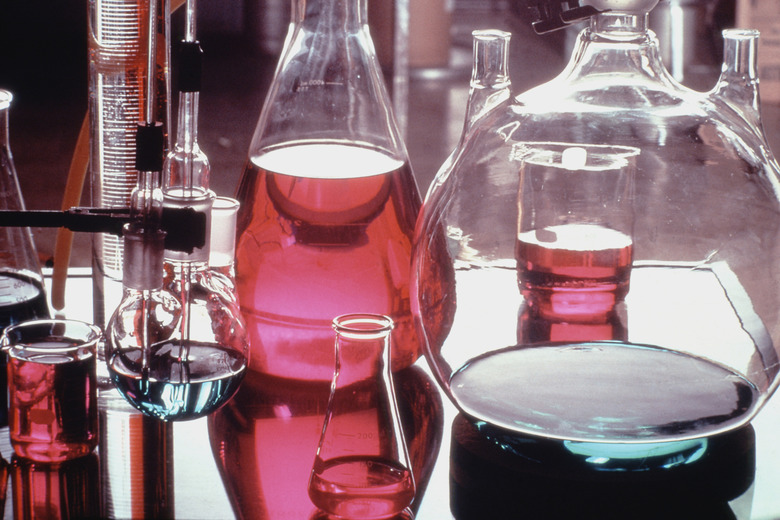Why Does Phenolphthalein Change Color?
The phenolphthalein indicator allows chemists to visually identify whether a substance is an acid or a base. The color change in phenolphthalein is a result of ionization, and this alters the shape of the phenolphthalein molecules.
What Is Phenolphthalein?
What Is Phenolphthalein?
Phenolphthalein (pronounced fee-nawl-thal-een), often abbreviated to phph, is a weak acid. This mildly acidic compound is a white to yellow crystalline solid. It easily dissolves in alcohols and is slightly soluble in water. Phenolphthalein is a large organic molecule with the chemical formula of C20H14O4.
Ionization and the Phenolphthalein Indicator
Ionization
and the Phenolphthalein
Indicator
Ionization occurs when a molecule gains or loses electrons, and this gives the molecule a negative or positive electric charge. Ionized molecules attract other molecules with the opposite charge and repel those with the same charge.
Phenolphthalein is a weak acid and is colorless in solution although its ion is pink. If hydrogen ions (H+, as found in an acid) were added to the pink solution, the equilibrium would switch, and the solution would be colorless. Adding hydroxide ions (OH-, as found in bases) will change the phenolphthalein into its ion and turn the solution pink.
Structure of Phenolphthalein
Structure
of Phenolphthalein
The phenolphthalein indicator has two different structures based on whether it is in an alkali (pink) or acid (colorless) solution. Both structures absorb light in the ultra-violet region, a region not accessible for the human eye. However, the pink form also absorbs in the visible light spectrum.
The reason for the visible light absorption is the structure of the pink form of the phenolphthalein indicator. Due to ionization, the electrons in the molecule are more delocalized than in the colorless form. Briefly, delocalization is when electrons in a molecule are not associated with a single atom, and instead are spread over more than one atom.
An increase in delocalization shifts the energy gap between molecular orbitals. Less energy is needed for an electron to make the jump into a higher orbital. The absorption of energy is in in the green region, 553 nanometers, of the light spectrum.
The human eye perceives a pink hue in the solution. The stronger the alkaline solution is, the more the phenolphthalein indicator changes and the darker the pink hue will be.
The Phenolphthalein pH Range
The Phenolphthalein
pH Range
The pH scale runs from 0 to 14, with a pH of 7 being neutral. A substance below pH 7 is considered acidic; above pH 7 is considered basic.
Phenolphthalein is naturally colorless but turns pink in alkaline solutions. The compound remains colorless throughout the range of acidic pH levels but begins to turn pink at a pH level of 8.2 and continues to a bright magenta at pH 10 and above.
Discovery, Manufacture and Uses of Phenolphthalein
Discovery, Manufacture and
Uses of Phenolphthalein
In 1871, the German chemist Adolf von Baeyer discovered phenolphthalein by fusing phenol and phthalic anhydride in the presence of sulfuric acid or zinc chloride, the manufacture process still used today.
In the chemistry laboratory, phenolphthalein is mostly used in acid-base titrations. A solution of known concentration is carefully added into one of unknown concentration. The phenolphthalein indicator is added into the unknown concentration. When the solution turns from colorless to pink (or vice versa), the titration or neutralization point has been reached, and the unknown concentration may be calculated.
In the past, phenolphthalein has been used as a laxative. It was a constituent of Ex-Lax for the over-the-counter relief of constipation. However, it was banned from use in the United States in 1999 after research showed it as a possible carcinogen (cancer-causing agent).
Cite This Article
MLA
Kozlowski, Rosann. "Why Does Phenolphthalein Change Color?" sciencing.com, https://www.sciencing.com/phenolphthalein-change-color-5271431/. 16 February 2020.
APA
Kozlowski, Rosann. (2020, February 16). Why Does Phenolphthalein Change Color?. sciencing.com. Retrieved from https://www.sciencing.com/phenolphthalein-change-color-5271431/
Chicago
Kozlowski, Rosann. Why Does Phenolphthalein Change Color? last modified August 30, 2022. https://www.sciencing.com/phenolphthalein-change-color-5271431/
